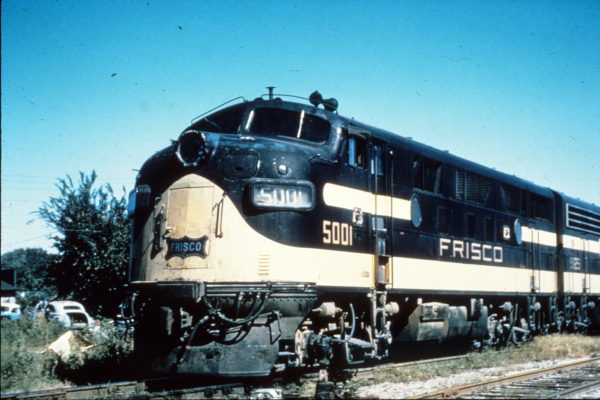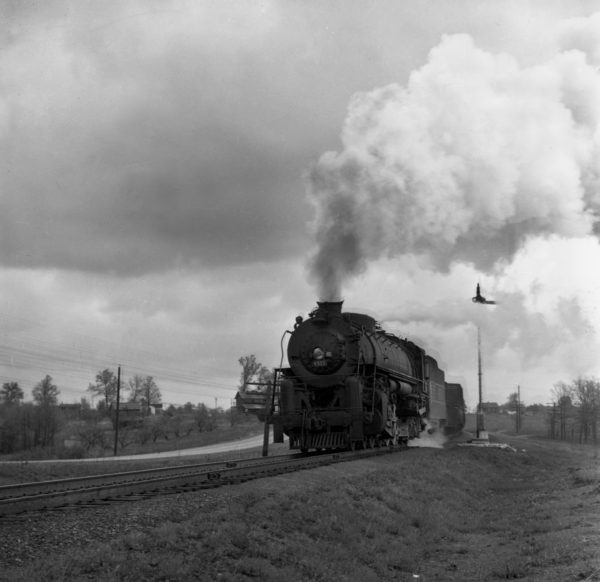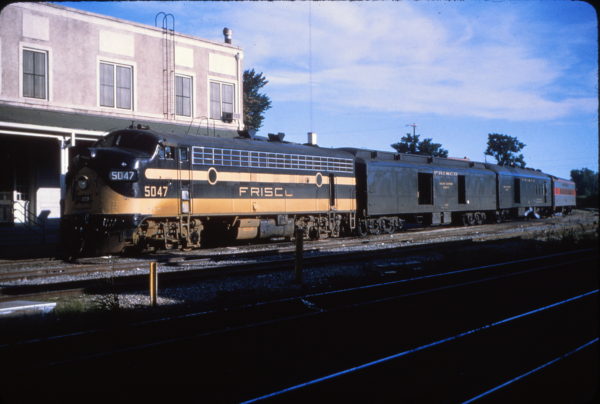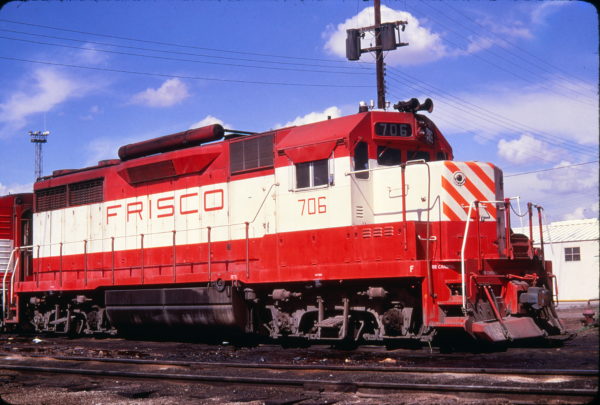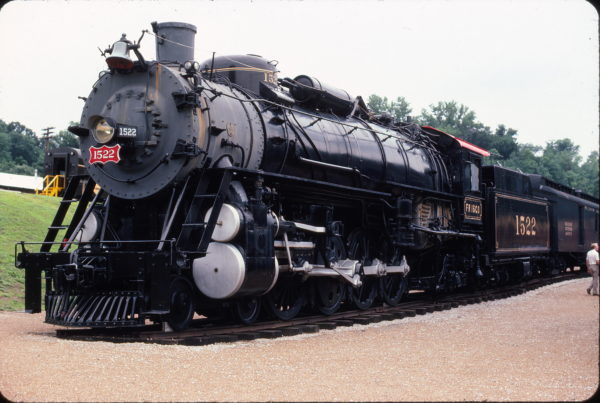Category Archives: BD Collection
Motorcar 2120
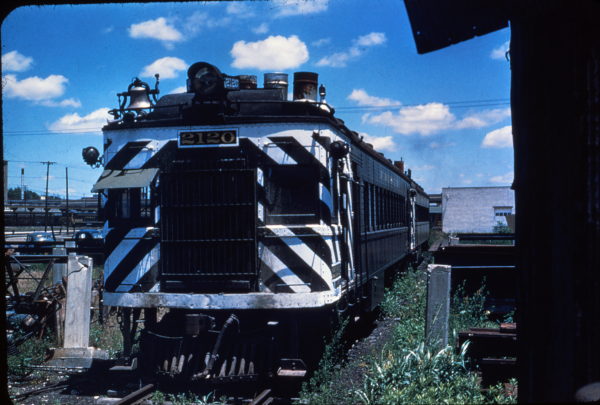
Motorcar 2120 at Springfield, Mo, Spring 1954 (M. Morrow from C. Dishinger Collection).
Bull Mooses 2120, 2121, and 2128 were last used on trains 773 and 774, which ran between Ardmore and Hope. Passenger service between Hugo and Hope died first, and the last run between these points was made on September 8, 1951. Moose 2121 was sent to Springfield, where it was dismantled during October 1951. Bull Mooses 2120 and 2128 soldiered on for two more years, until passenger service between Hugo and Ardmore was discontinued on November 8, 1953. Cars 2120 and 2128 lasted until May 1954, when they were cut-up in Springfield. The car behind 2120 in the image is no doubt number 2128, which was a Sykes car (note the difference in the window pier). Given this history, the picture was most likely taken in Springfield. Note the mud spatters on the face of 2120; she has obviously been drug to Springfield by local freights. The picture was taken during the Spring of 1954.
Special thanks to Karl Brand for the commentary.
4-8-4 4513
FP7 5047
44-Ton Switcher 8
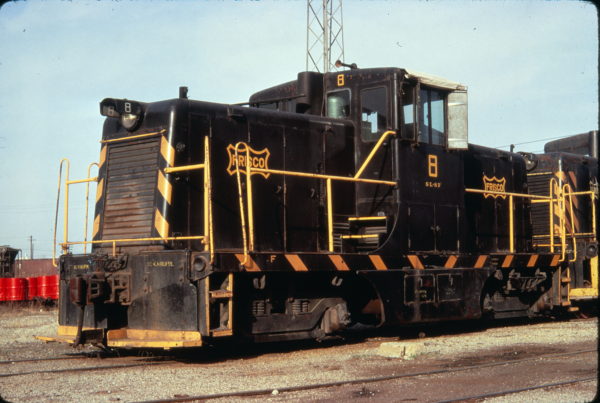
44-Ton Switcher 8 at Tulsa, Oklahoma in April 1971 (Golden Spike Productions).
The locomotives are in the Mechanical Department’s locomotive service tracks area at Cherokee Yard. In this photograph are GE 44-ton switch engines SLSF 8 and, coupled to its rear, SLSF 7. Number 7 is sitting on non-powered shop trucks. Its normal trucks and traction motors are being rebuilt in the shop.
Please see these posts as well: 1, 2, 3.
Special thanks to Mark Davidson.
Boxcar 600120
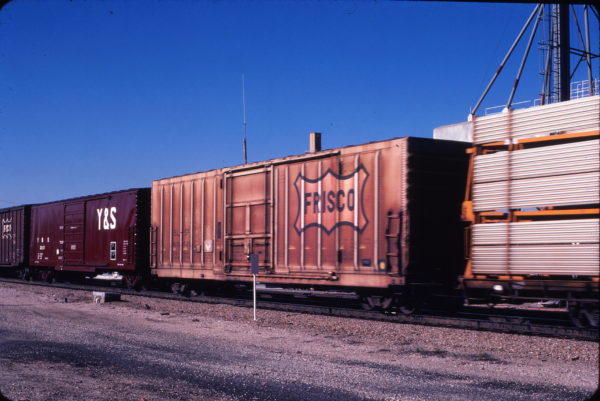
Boxcar 600120 (location unknown) in December 1979 (Bob Dye).
600120 is one of 165 similar exterior post, bulkhead loader, insulated boxcars (XLI) in the series 600000-600164. These cars were constructed by Pacific Car and Foundry (PCF) in November and December 1971.
Exterior features included exposed reinforcing posts, Youngstown 10 foot 6 inch plug doors, Stanray car ends and short four-rung ladders at the car’s corners. The cars were equipped with Keystone 20-inch cushioned underframes. The interior featured Preco adjustable bulkheads to prevent load shifting during transit.
The cars were painted light tan or beige. Car reporting marks, numbers and other lettering was black. They featured an extra large coonskin herald to the right of the plug door. This herald had black lettering and outline with a white interior background.
The primary assignment for cars in this series was hauling beer for the Schlitz Brewing Company. The cars design proved so successful and demand was so high that the railroad ordered an almost identical additional 100 cars. These were delivered in July 1974 in the series 700000-700099.
The view is looking northwest.
Special thanks to Mark Davidson.
GP35 706
4-8-2 1522
GP7 533
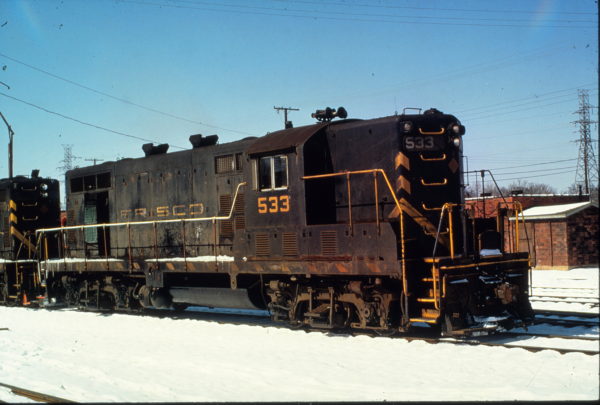
GP7 533 at St. Louis, Missouri (date unknown).
The photograph was taken at Lindenwood Yard. This is the Mechanical Department’s locomotive service tracks area northeast of the diesel shop. The north arm of the sand tower is visible above the second unit.
The high tension power line towers stand along and just south of the River Des Peres. This river runs along the northwest side of the yard, drains southwest, then east into the Mississippi River south of St Louis.
The view is looking northwest.
Special thanks to Mark Davidson.
SD45 906
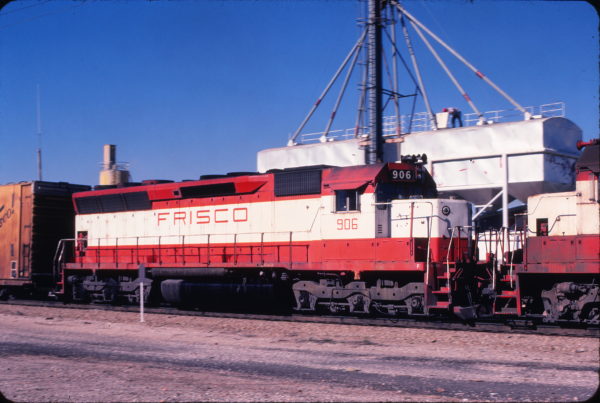
SD45 906 at Aurora, Missouri in December 1979 (Bob Dye).
This train is eastbound on the Springfield Subdivision. The train is just before the North Elliott Avenue crossing at mile post 268.74. The Frisco depot (MP 268.9) is south of the tracks, one block to the west. Its address is 100 South Madison Avenue. Further west, just beyond the depot is the Missouri Pacific diamond crossing at MP 269.0. This railroad crossing at grade is protected by an automatic interlocking.
The train’s locomotive consist includes at least four units. These include GP38-2s 458 and 473, an unidentified EMD unit and SD45 906. SD45 906 is being moved dead in consist. Note that there is no multiple unit electrical cable, the crossover step on the unidentified unit is up and the crossover chains are not connected between the units. Please see this related Frisco Archive image.
The elevator leg, distribution pipes and hopper storage bins are located at the Aurora Agri-Center. They are located at 29 North Elliott Avenue. In the distance above the locomotive’s radiator section is part of a ready-mix concrete batch plant. The business is Kay Concrete Materials at 30 East Mill Street.
Just behind the photographer is the Elliott Avenue grade crossing with the Missouri Pacific Railroad. This route is the southern section of the MoP’s Carthage Subdivision. One half mile to the north (compass west) their north/south line crosses the Frisco at MoP’s MP 489.6. On the immediate southwest quadrant of the Elliott Avenue crossing is their brick depot at 121 East Olive Street at their MP 489.1. Today, this depot is co-occupied by the Aurora Chamber of Commerce and Aurora Historical Society.
The view is looking north northeast.
Special thanks to Mark Davidson.
